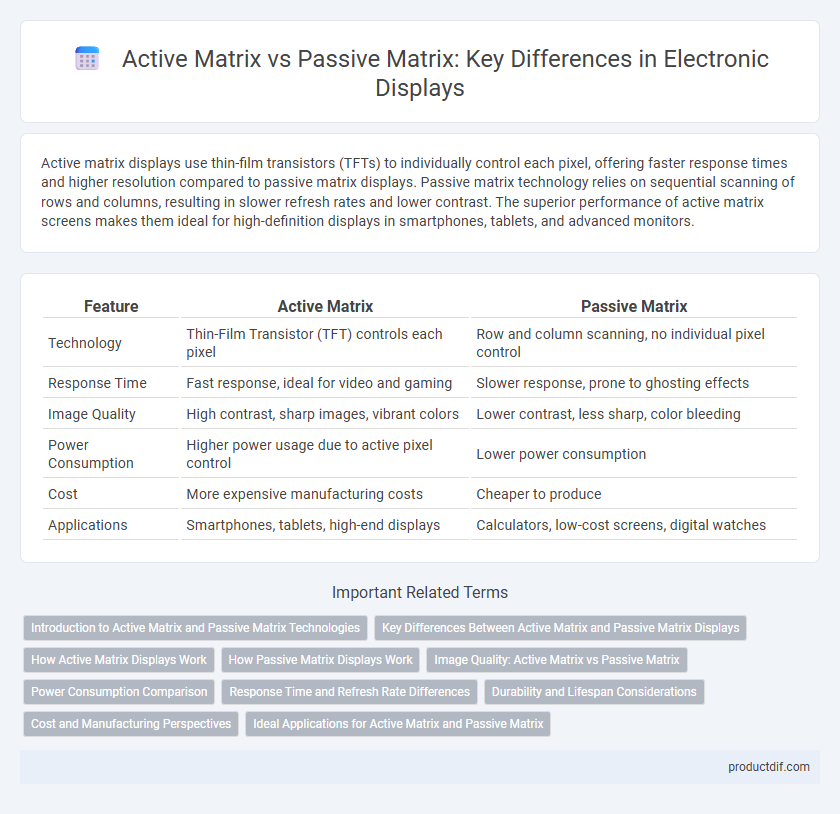Active matrix displays use thin-film transistors (TFTs) to individually control each pixel, offering faster response times and higher resolution compared to passive matrix displays. Passive matrix technology relies on sequential scanning of rows and columns, resulting in slower refresh rates and lower contrast. The superior performance of active matrix screens makes them ideal for high-definition displays in smartphones, tablets, and advanced monitors.
Table of Comparison
| Feature | Active Matrix | Passive Matrix |
|---|---|---|
| Technology | Thin-Film Transistor (TFT) controls each pixel | Row and column scanning, no individual pixel control |
| Response Time | Fast response, ideal for video and gaming | Slower response, prone to ghosting effects |
| Image Quality | High contrast, sharp images, vibrant colors | Lower contrast, less sharp, color bleeding |
| Power Consumption | Higher power usage due to active pixel control | Lower power consumption |
| Cost | More expensive manufacturing costs | Cheaper to produce |
| Applications | Smartphones, tablets, high-end displays | Calculators, low-cost screens, digital watches |
Introduction to Active Matrix and Passive Matrix Technologies
Active matrix technology uses thin-film transistors (TFTs) to control each pixel individually, resulting in faster response times and superior image quality compared to passive matrix displays. Passive matrix technology relies on scanning and controlling rows and columns without individual pixel control, leading to slower refresh rates and lower resolution. Active matrix is commonly found in modern LCDs and OLEDs, offering enhanced brightness, contrast, and reduced motion blur.
Key Differences Between Active Matrix and Passive Matrix Displays
Active matrix displays use a thin-film transistor (TFT) array to control individual pixels, offering faster response times, higher resolution, and better color accuracy compared to passive matrix displays, which rely on simpler row and column scanning techniques. Passive matrix displays tend to have slower refresh rates and lower contrast ratios, making them less suitable for dynamic or high-definition content. The key difference lies in the addressing method: active matrix provides precise pixel control via dedicated transistors, while passive matrix controls pixels through multiplexed signals, impacting display performance and power consumption.
How Active Matrix Displays Work
Active matrix displays use thin-film transistors (TFTs) at each pixel to control the voltage, enabling precise and rapid switching of individual pixels. This technology allows for higher resolution, faster response times, and improved image clarity compared to passive matrix displays. Each pixel is activated by a dedicated transistor, maintaining constant voltage and reducing crosstalk.
How Passive Matrix Displays Work
Passive matrix displays operate by addressing rows and columns sequentially using a grid of conductive lines, where each intersection corresponds to a pixel controlled through voltage application. The display relies on multiplexing to activate pixels, resulting in slower response times and lower contrast compared to active matrix technology. These displays are simpler and cheaper to manufacture but suffer from ghosting effects and limited brightness uniformity due to the lack of individual pixel driving transistors.
Image Quality: Active Matrix vs Passive Matrix
Active matrix displays provide superior image quality with higher contrast ratios, faster refresh rates, and better color accuracy compared to passive matrix screens. Passive matrix technology often suffers from slower response times and lower resolution, resulting in ghosting and reduced image sharpness. For applications demanding crisp visuals and smooth motion, active matrix panels are the preferred choice.
Power Consumption Comparison
Active matrix displays consume less power than passive matrix displays by efficiently controlling individual pixels through thin-film transistors, reducing the need for constant refreshing. Passive matrix technology requires higher voltage and frequent scanning to maintain images, leading to increased power consumption. This makes active matrix the preferred choice for energy-efficient LCDs in smartphones and laptops.
Response Time and Refresh Rate Differences
Active matrix displays feature faster response times and higher refresh rates compared to passive matrix technology, resulting in smoother motion rendering and reduced ghosting effects. The active matrix uses thin-film transistors (TFTs) at each pixel to control voltage individually, allowing rapid updates and precise control. Conversely, passive matrix displays rely on multiplexing signals without individual pixel control, leading to slower response times and lower refresh rates that can cause motion blur and flickering.
Durability and Lifespan Considerations
Active matrix displays offer superior durability and longer lifespan compared to passive matrix technology due to their individual pixel control, which reduces strain and improves image stability. Passive matrix screens typically suffer from faster degradation and lower longevity due to slower refresh rates and increased power consumption. Choosing active matrix technology enhances overall device reliability and extends operational lifespan in electronic displays.
Cost and Manufacturing Perspectives
Active matrix displays require more complex thin-film transistor (TFT) technology, leading to higher manufacturing costs compared to passive matrix displays that use simpler grid-based controls. Passive matrix screens are cheaper to produce but generally suffer from slower response times and lower display quality. Manufacturing complexity and material costs make active matrix the preferred choice for high-resolution, high-performance electronic devices despite its premium price.
Ideal Applications for Active Matrix and Passive Matrix
Active matrix displays, utilizing thin-film transistors (TFT), excel in high-resolution applications such as smartphones, tablets, and laptops where fast response times and superior image quality are crucial. Passive matrix displays are better suited for low-cost, low-power devices like digital clocks, calculators, and simple industrial monitors due to their simpler design and reduced manufacturing expenses. The choice depends on the need for vivid colors and rapid refresh rates versus energy efficiency and cost-effectiveness.
Active Matrix vs Passive Matrix Infographic

 productdif.com
productdif.com